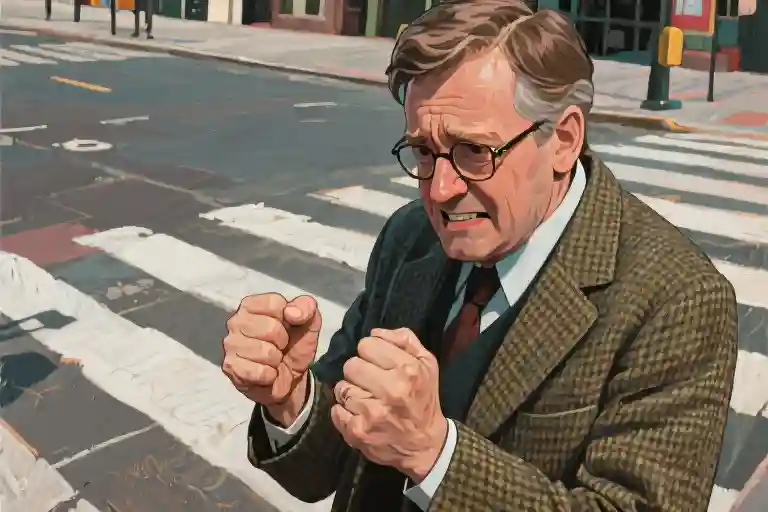He stood at the crosswalk with the impatient energy of someone who’d spent too many years waiting – for peer reviews, for tenure decisions, for any sign that his work mattered. His hands kept clenching and unclenching, the knuckles whitening then relaxing in a rhythm that matched the pedestrian signal’s countdown. I remember thinking it was just academic stress – the universal condition of anyone trying to survive humanities academia these days. What I couldn’t know was that in five years he’d be dead by his own hand, or that his final unpublished manuscript would be titled ‘From Starbuck to Starbucks: The Commercialization of the American Literary Conscience.’
There’s a particular way professors carry their burdens. Not in briefcases or backpacks, but in the shoulders that hunch slightly forward as if bracing against another rejection letter, in the fingers that unconsciously mimic typing motions during department meetings. That day at the intersection, I saw all the unspoken pressures of academia written in his posture: the publish-or-perish reality, the absurdity of researching Melville’s minor characters while student loan debts mounted, the quiet humiliation of seeing your life’s work reduced to a corporate coffee chain’s naming inspiration.
We pretend academic stress is cerebral, but the body always betrays us. His fists kept time like metronomes measuring out the remaining patience of a scholar who’d spent thirty years analyzing nineteenth-century maritime fiction, only to watch his most cited work become a trivia answer about mermaid logos. The light changed, he crossed, and I went about my day – not realizing I’d witnessed a man drowning in plain sight, weighted down by monographs no one read, lectures no one attended, and a system that values Starbucks’ quarterly profits more than Starbuck’s literary significance.
The Clenched Fist: Body Language of Academic Stress
He stood motionless at the crosswalk, his hands performing that quiet, rhythmic ballet – clenching, unclenching, clenching again. The tendons on the back of his hands rose like bridge cables under skin that had begun its slow surrender to time. At fifty-something, he carried himself with that particular posture common to humanities professors: shoulders slightly rounded from years leaning over texts, head tilted at an angle that suggested perpetual listening or perhaps mild hearing loss from too many crowded faculty meetings.
What struck me then wasn’t just the tension in those hands, but their terrible isolation. They moved without audience or witness, performing their anxious ritual for an indifferent city street. Only later would I understand those fists held more than stress – they contained the entire precarious ecosystem of modern academia.
The American Association of University Professors reports 72% of humanities faculty experience chronic physical manifestations of stress, with hand tremors and muscle tension ranking among the most common. These symptoms don’t emerge from any single crisis, but from the slow compression of expectations: publish two peer-reviewed articles annually while maintaining a 4.8/5 teaching evaluation average, secure external funding for research that resists monetization, and somehow produce a monograph that will satisfy both tenure committees and the six hypothetical readers who might engage with your work.
That man’s fists mapped perfectly to the contradictions of his profession. The clench mirrored the vise-grip of institutional demands – the unclenching, that fleeting hope of release that never quite arrives. I’ve since come to recognize this gesture as academia’s silent tell, as distinctive as a gambler’s nervous tick or a pianist’s finger exercises. We perform our stress in miniature, through hands that want to both grasp success and push away the unbearable weight of its requirements.
What makes the humanities particularly susceptible to these physical manifestations? Unlike STEM fields where stress often stems from equipment failures or funding shortfalls, our crises are quieter and more insidious. The pressure to produce ‘original contributions to knowledge’ about well-trodden texts, the gnawing awareness that one’s life’s work might gather dust in library storage facilities, the peculiar horror of realizing your most cited paper is the one you consider your least important – these anxieties don’t explode, they accumulate.
Those fists stay with me because they embody academia’s central paradox. We spend our careers analyzing the human condition through texts, yet often fail to read the most immediate text of all – the story our own bodies write daily in the language of tension and release. The professor at the crosswalk wasn’t just waiting for the light to change; he was suspended between the need to hold on and the desperate wish to let go.
The Publish-or-Perish Paradox
The pressure to produce original research in academia isn’t just about intellectual curiosity—it’s a survival mechanism. Consider the literature professor spending years analyzing the nautical terminology in Moby-Dick, knowing full well the dissertation will likely gather dust in some university archive. Yet without these niche publications, tenure committees raise eyebrows, promotion files grow thinner, and CVs begin resembling half-empty lifeboats.
What makes this system particularly absurd becomes clear when comparing disciplines. While STEM researchers chase billion-dollar grants for quantum computing or cancer vaccines, humanities scholars debate whether Starbuck (the Pequod‘s first mate) would have preferred a pumpkin spice latte. The disparity in resources isn’t merely financial—it’s existential. A biochemistry lab can measure its impact in clinical trials and patents; how does one quantify the value of interpreting Captain Ahab’s monologues for the 217th time?
The real tragedy surfaces when brilliant minds contort themselves to fit institutional molds. I once met a medievalist who pivoted to studying ‘Game of Thrones fan theories’ because her department demanded ‘relevance.’ Another colleague spent three years examining Dickensian dining scenes solely because the university press had an open slot in their ‘Victorian Material Culture’ series. These aren’t passion projects—they’re academic Hail Marys thrown to satisfy arbitrary quotas.
Yet beneath the dark humor lies a sobering truth: this system doesn’t just produce obscure papers—it shapes lives. Those clenched fists at crosswalks? They’re often holding the weight of sacrificed relationships, abandoned creative pursuits, and the quiet shame of knowing one’s life’s work might only ever be peer-reviewed by seven people. The publish-or-perish machine keeps grinding, indifferent to whether it polishes gems or pulverizes souls.
Perhaps the cruelest irony is how this mirrors the very themes we dissect in literature—Ahab’s futile obsession, Bartleby’s quiet resistance, Gatsby’s endless striving. The academy, meant to be a sanctuary for thought, has become its own Great White Whale: massive, consuming, and just as likely to drag us under as to inspire awe.
From Starbuck to Starbucks: The Commercial Hijacking of Literary Classics
The irony isn’t lost on anyone who’s actually read Moby Dick. There’s something profoundly absurd about millions of people daily ordering venti caramel macchiatos from a coffee chain named after a minor character in Herman Melville’s 1851 masterpiece. Starbuck, the first mate of the Pequod, was described as “steady, steadfast, and scrupulous” – qualities that bear little resemblance to the sugary, pumpkin-spiced reality of modern coffee culture.
This cultural appropriation reveals how commercial enterprises plunder literary classics for marketable names while stripping away all original context and meaning. The original Starbuck represented moral conscience in the novel, the voice of reason against Ahab’s monomaniacal quest. Today’s Starbucks represents corporate consistency and seasonal latte flavors. The connection begins and ends with the name itself, a hollowed-out literary reference repurposed for brand recognition.
Academic researchers spend years painstakingly analyzing every comma in Melville’s text, debating the philosophical implications of Starbuck’s character, while multinational corporations casually scoop up these references like seashells on a beach – pretty objects to decorate their marketing materials. There’s a particular cruelty in watching the careful work of literary scholars become reduced to trivia questions on coffee cups.
The commercialization of literary symbols creates a peculiar dissonance in academia. Professors who’ve dedicated their careers to Melville studies might find themselves explaining Starbuck’s symbolism to students who only recognize the name from frappuccino cups. The original text becomes secondary to its commercial adaptation, like Shakespeare reduced to motivational office posters.
What makes this phenomenon particularly jarring is the contrast between how academia and business treat these cultural references. Scholars will debate for decades whether Starbuck’s resistance to Ahab represents Christian morality or pragmatic self-preservation. Meanwhile, the coffee company simply needed a name that sounded vaguely nautical and started with ‘star.’ The same literary symbols that fuel years of academic debate become disposable branding tools in the commercial world.
This isn’t just about Starbucks or Melville. It’s about how our culture processes and commodifies art. The same fate has befallen countless literary references – from Dante’s Inferno inspiring video games to Jane Austen’s novels becoming templates for romantic comedies. The original complexity gets flattened into marketable simplicity.
Perhaps most ironically, while literature professors struggle to secure funding for their obscure Melville conferences, the coffee company that borrowed his character’s name operates with budgets that dwarf most university endowments. The very scholars who could explain the rich history behind these literary references watch as corporations profit from their superficial use.
There’s no malice in this commercial appropriation – just the relentless machinery of capitalism finding useful fragments wherever they can be mined. But it does create a strange cultural landscape where deep engagement with texts becomes increasingly rare while their hollowed-out shells proliferate in consumer spaces. The original Starbuck would probably be horrified to see what became of his name.
The Clenched Fist or the Open Hand: Humanities’ Existential Crossroads
The professor’s hands keep clenching and unclenching at the crosswalk, a nervous tic that mirrors the perpetual motion of academic production – write, publish, repeat. Those fists contain the quiet desperation of a system that measures worth by citations rather than comprehension, by output rather than insight. In the cold calculus of modern academia, a scholar studying Starbuck the fictional harpooner might envy Starbucks the corporate empire’s market penetration.
What happens when the pursuit of knowledge becomes indistinguishable from the production of knowledge? The humanities face their perennial crisis with renewed urgency, caught between the publish-or-perish machinery and a culture increasingly skeptical of non-STEM fields. That tension lives in the professor’s restless hands – the instinct to grasp tightly to disciplinary standards while the world moves toward more pragmatic concerns.
Perhaps we’ve misunderstood the purpose of humanistic inquiry. The value of analyzing Melville’s minor characters doesn’t lie in some eventual commercial application, but in the cultivation of what Edward Said called “amateurism” – the freedom to pursue ideas without professionalized constraints. When a literature professor unpacks the symbolism in Queequeg’s coffin, they’re not solving supply chain issues for funeral homes; they’re preserving the human capacity to find meaning in our shared stories.
Public engagement offers one path forward. The same scholarly rigor applied to esoteric journal articles could illuminate contemporary issues when translated for general audiences. Imagine academic presses producing companion pieces to monographs – not dumbed down versions, but differently framed interpretations. That paper on Starbuck’s moral compass might resonate more if connected to modern business ethics debates rather than buried in specialist discourse.
Alternative metrics could help. Why not count public lectures or open-access commentaries alongside traditional publications? The professor clenching his fists might relax them if allowed to write occasional essays unpacking literary references in popular culture – demonstrating relevance without sacrificing depth. Some institutions already recognize this, creating “public scholar” positions that bridge campus and community.
The hands at the crosswalk eventually unclench, but the tension remains. Humanities don’t need to justify themselves through commercial viability or measurable impact. Their value lives in that stubborn insistence on asking unprofitable questions, in keeping alive conversations that began centuries before any corporate branding strategy. Maybe the answer isn’t tighter fists or complete surrender, but hands that know when to grasp firmly and when to open – to scholarship, to public engagement, to the messy business of finding meaning where algorithms see none.
The Unclenched Fist: When the System Keeps Squeezing
The professor’s hands stayed with me long after that day at the crosswalk. Not just the memory of his rhythmic clenching, but the way his fingers finally went slack when the light changed – as if even his body couldn’t sustain that level of tension indefinitely. Yet the system that put that tension there never seems to tire. It keeps squeezing, demanding another monograph, another citation, another justification for why parsing 19th century whaling narratives matters in an age where literature gets reduced to coffee shop logos.
We pretend this is normal. That it’s reasonable for someone to spend years analyzing Starbuck’s moral compass in Moby Dick while actual Starbucks baristas steam milk beneath a cartoon siren. The absurdity would be laughable if it weren’t so costly – not just in grant money or departmental budgets, but in the quiet desperation of scholars who’ve built careers on being meticulously wrong about things nobody questions. There’s a particular agony in realizing your life’s work has been scrupulous in all the ways that don’t count.
What’s left when you unclench? Not relief, usually. Just the dawning awareness of how little space exists between what the academy demands and what the world ignores. The professor I saw likely understood this better than most – that his carefully footnoted arguments about Melville’s nautical hierarchies would never compete with the mermaid on a paper cup. The tragedy isn’t that he cared about obscure literary references, but that the system made him care more about cataloging them than considering why they resonate (or fail to) beyond the ivory tower.
Perhaps the real scholarly rebellion isn’t producing more work, but learning when to let go. Not of ideas, but of the death grip we maintain on institutional validation. What if the most radical act available to academics isn’t another publication, but the courage to ask – really ask – whether their clenched fists are holding onto something vital, or just propping up a system that confuses rigor with rigor mortis?
The light always changes eventually. The question is whether we’ll cross the street, or just keep standing there, squeezing.



